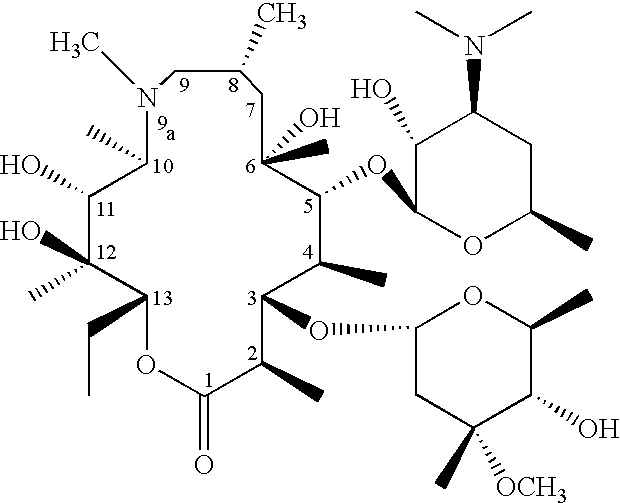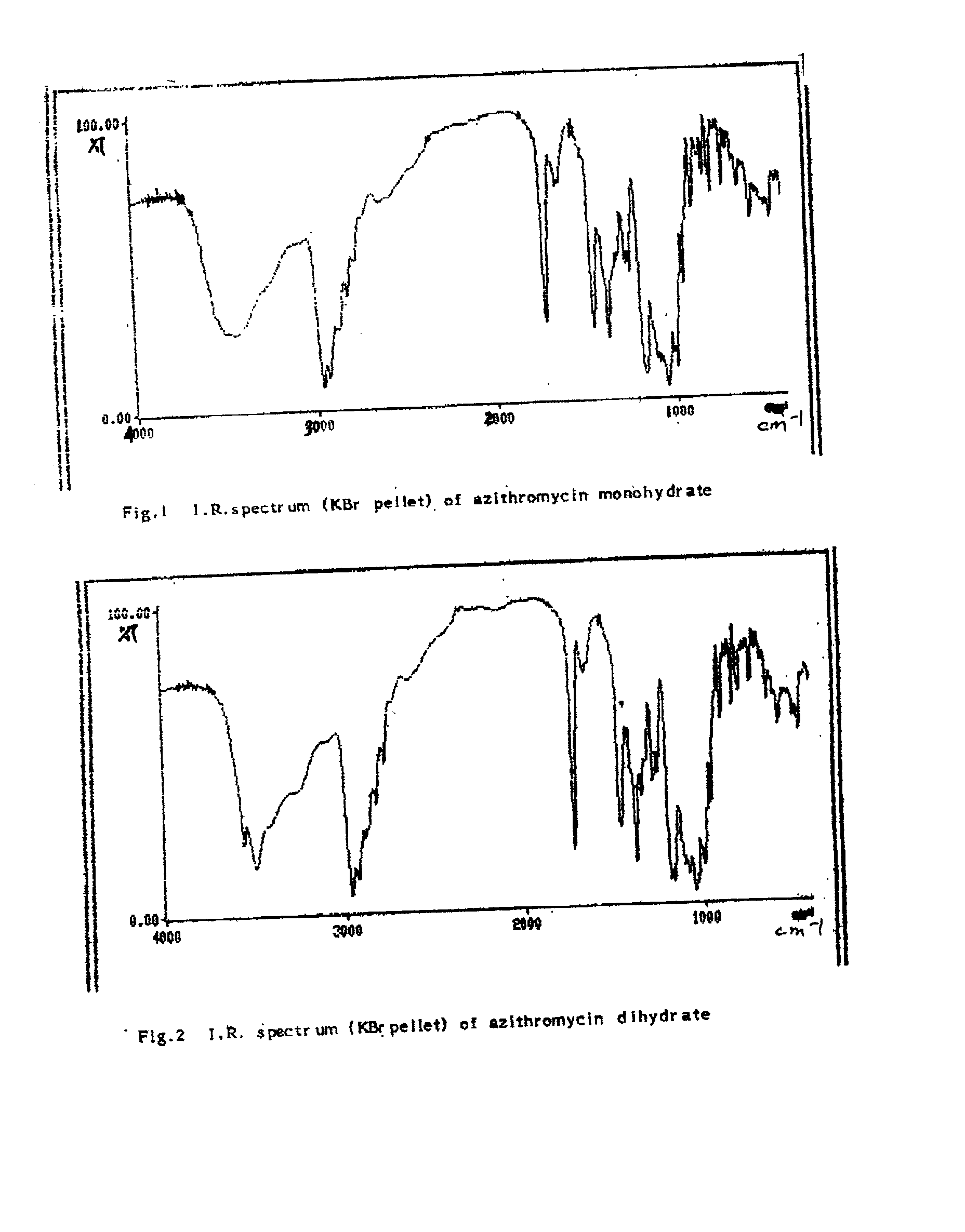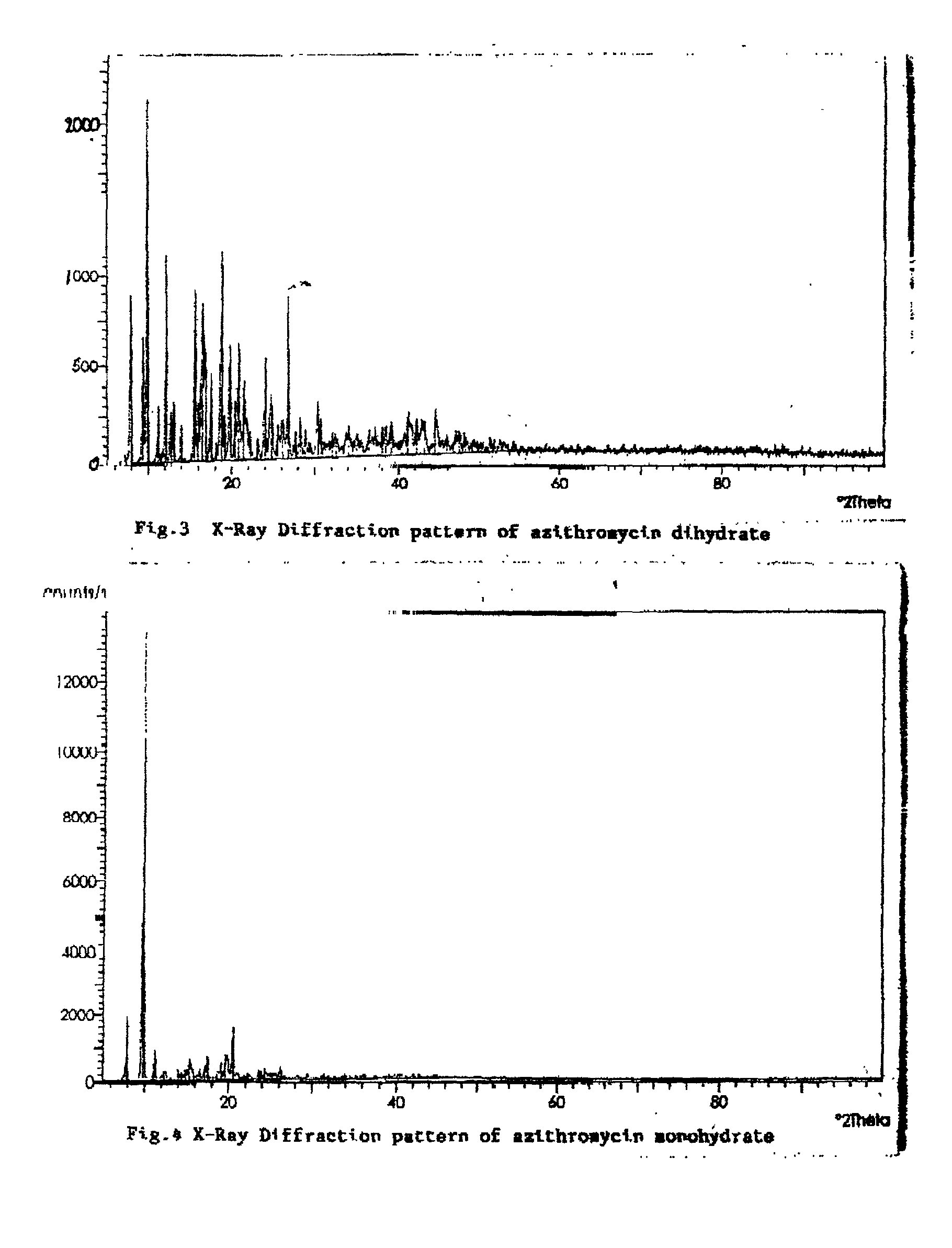Process for the preparation of non-hygroscopic azithromycin dihydrate
a technology of azithromycin and dihydrate, which is applied in the field of process for the production of non-hygroscopic azithromycin dihydrate, can solve the problems of high recovery cost, inability to handle monohydrate azithromycin, and inability to recover from infection
- Summary
- Abstract
- Description
- Claims
- Application Information
AI Technical Summary
Problems solved by technology
Method used
Image
Examples
example 2
[0039] Example 2
Preparation of Azithromycin Dihydrate from Hygroscopic Azithromycin Monohydrate Using Acetonitrile : Water Mixture.
[0040] 10 gms of hygroscopic azithromycin-monohydrate was suspended in a mixture of acetonitrile (10 ml) and water (10 ml) and stirred at ambient temperature. The transformation of cubical crystals of monohydrate form to the rhomboid form crystals of dihydrate was followed by checking the crystal habit under a microscope at every two hour interval. At 8 hours the rhomboid dihydrate crystals only were seen. The slurry was filtered and dried under vacuum at 50.degree. C. to give 9.8 g of azithromycin dihydrate. It had a melting point of 126-128.degree. C. and water content of 4.68% (Theoretical 4.586) (by Karl-Fischer titration method). It has a characteristic solid state IR spectrum (KBr pellet) (FIG. 2) and x-ray diffraction pattern (FIG. 3). On exposure to ambient atmosphere there was no change in the moisture content of the dihydrate crystals.
example 3
[0041] Example 3
Preparation of Azithromycin Dihydrate from Hygroscopic Azithromycin Monohydrate Using Dimethyl Formamide: Water Mixture.
[0042] 10 gms of hygroscopic azithromycin-monohydrate was suspended in a mixture of dimethyl formamide (10 ml) and water (10 ml) and stirred at ambient temperature. The transformation of cubical crystals of monohydrate form to the rhomboid form crystals of dihydrate was followed by checking the crystal habit under a microscope at hourly interval. At 3 hours the rhomboid dihydrate crystals only were seen. The slurry was filtered and dried under vacuum at 50.degree. C. to give 9.8 g of azithromycin dihydrate. It had a melting point of 126-128.degree. C. and water content of 4.6% (Theoretical 4.586) (by Karl-Fischer titration method). It has a characteristic solid state IR spectrum (KBr pellet) (FIG. 2) and x-ray diffraction pattern (FIG. 3). On exposure to ambient atmosphere there was no change in the moisture content of the dihydrate crystals.
example 4
[0043] Example 4
Preparation of Azithromycin Dihydrate from Hygroscopic Azithromycin Monohydrate Using Dimethyl Acetamide: Water Mixture.
[0044] 10 gms of hygroscopic azithromycin-monohydrate was suspended in a mixture of dimethyl acetamide (10 ml) and water (10 ml) and stirred at ambient temperature. The transformation of cubical crystals of monohydrate form to the rhomboid form crystals of dihydrate was followed by checking the crystal habit under a microscope at every two hour interval. At 4 hours the rhomboid dihydrate crystals only were seen. The slurry was filtered and dried under vacuum at 50.degree. C. to give 9.8 g of azithromycin dihydrate. It had a melting point of 126-128.degree. C. and water content of 4.63% (Theoretical 4. 586) (by Karl-Fischer titration method). It has a characteristic solid state IR spectrum (KBr pellet) (FIG. 2) and x-ray diffraction pattern (FIG. 3). On exposure to ambient atmosphere there was no change in the moisture content of the dihydrate crysta...
PUM
| Property | Measurement | Unit |
|---|---|---|
| melting point | aaaaa | aaaaa |
| melting point | aaaaa | aaaaa |
| melting point | aaaaa | aaaaa |
Abstract
Description
Claims
Application Information
 Login to View More
Login to View More - R&D
- Intellectual Property
- Life Sciences
- Materials
- Tech Scout
- Unparalleled Data Quality
- Higher Quality Content
- 60% Fewer Hallucinations
Browse by: Latest US Patents, China's latest patents, Technical Efficacy Thesaurus, Application Domain, Technology Topic, Popular Technical Reports.
© 2025 PatSnap. All rights reserved.Legal|Privacy policy|Modern Slavery Act Transparency Statement|Sitemap|About US| Contact US: help@patsnap.com



